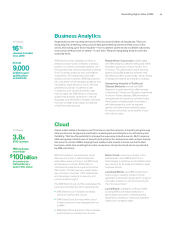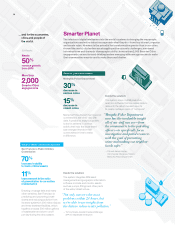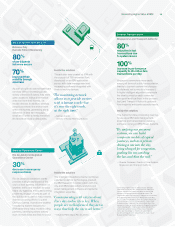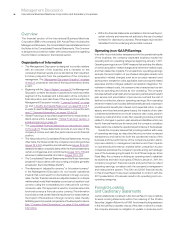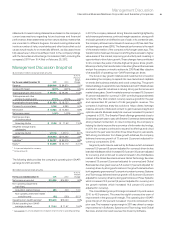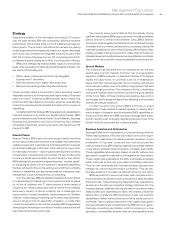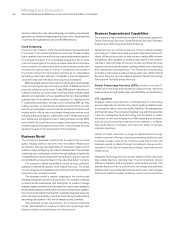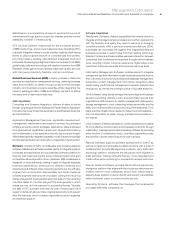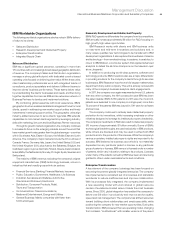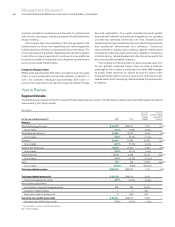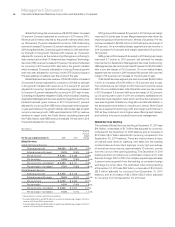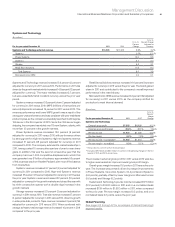IBM 2011 Annual Report Download - page 24
Download and view the complete annual report
Please find page 24 of the 2011 IBM annual report below. You can navigate through the pages in the report by either clicking on the pages listed below, or by using the keyword search tool below to find specific information within the annual report.22
Management Discussion
International Business Machines Corporation and Subsidiary Companies
decision making through natural language processing, hypotheses
generation and evidence-based learning. It Is another unique example
of just how far organizations can go with IBM analytics.
Cloud Computing
Cloud is a new model for consuming and delivering business and
IT services. It can deliver significant economies of scale, enable
higher qualities of service and even serve as a transformative platform
for business innovation. From a business perspective, the promise
of cloud computing lies in the ability to shape influential communities,
launch product innovations and explore new business models with
minimal time, cost and effort. From an IT perspective, the power of
the model comes from harnessing vast stores of underutilized
technology with highly efficient virtualization and management,
consumer-style user interfaces and ubiquitous broadband.
IBM has already helped thousands of its clients adopt and leverage
cloud computing through its broad portfolio of IBM SmartCloud
products, solutions and services. Today, IBM delivers many line-of-
business solutions via cloud-based hosting models, enabling rapid
adoption and exploration of new capabilities that can drive significant
business value for its clients and their customers. For developers and
IT organizations seeking to leverage cloud computing, IBM can help
build out private, on-premise cloud-based environments, provide
security and integration services across private and hybrid cloud
models, and/or offer its own cloud-based infrastructure and services,
including advanced analytics, collaboration, and IT infrastructure such
as virtual servers, storage and tools for testing software. Across IBM’s
entire SmartCloud portfolio, the company offers expert consulting,
breakthrough technologies and a portfolio of cloud-based services
squarely focused on the requirements of the enterprise.
Business Model
The company’s business model is built to support two principal
goals: helping clients to become more innovative, efficient and
competitive through the application of business insight and IT
solutions; and providing long-term value to shareholders. The business
model has been developed over time through strategic investments
in capabilities and technologies that have superior long-term growth
and profitability prospects based on the value they deliver to clients.
The company’s global capabilities include services, software,
systems, fundamental research and related financing. The broad
mix of businesses and capabilities are combined to provide integrated
solutions to the company’s clients.
The business model is resilient, adapting to the continuously
changing market and economic environment. The company continues
to divest certain businesses and strengthen its position through
strategic organic investments and acquisitions in higher-value segments
like business analytics, smarter planet and cloud computing. In addition,
the company has transformed itself into a globally integrated enterprise
which has improved overall productivity and is driving investment and
expanding participation in the world’s fastest growing markets.
This business model, supported by the company’s financial
model, has enabled the company to deliver strong earnings, cash
flows and returns to shareholders over the long term.
Business Segments and Capabilities
The company’s major operations consists of five business segments:
Global Tech nology Services, Global Business Services, Soft ware,
Systems and Technology and Global Finan cing.
Global Services is a critical component of the company’s strategy
of providing IT infrastructure and business insight and solutions to
clients. While solutions often include industry-leading IBM software
and systems, other suppliers’ products are also used if a client solution
requires it. Approximately 60 percent of external Global Services
segment revenue is annuity based, coming primarily from outsourcing
and maintenance arrangements. The Global Services backlog
provides a solid revenue base entering each year. Within Global
Services, there are two reportable segments: Global Tech nology
Services and Global Business Services.
Global Technology Services (GTS) primarily provides IT
infra structure services and business process services, delivering
business value through global scale, standardization and automation.
GTS Capabilities
Strategic Outsourcing Services: comprehensive IT outsourcing
services dedicated to transforming clients’ existing infrastructures
to consistently deliver improved quality, flexibility, risk management
and financial value. The company integrates long-standing expertise
in service management and technology with the ability to exploit
the power of new technologies from IBM systems and software,
such as cloud computing, analytics and virtualization, to deliver
high performance, innovation and improved ability to achieve
business objectives.
Global Process Services: a range of standardized through
transformational offerings including processing platforms and
business process outsourcing. These services deliver improved
business results to clients through the strategic change and/or
operation of the client’s business processes, applications and
infrastructure.
Integrated Technology Services: project-based portfolio of services
that enable clients to optimize their IT environments by driving
efficiency, flexibility and productivity, while reducing costs. The
standardized portfolio is built around key assets and patented
software, and incorporates best practices and proven methodologies
that ensure predictive quality of delivery, security and compliance.



